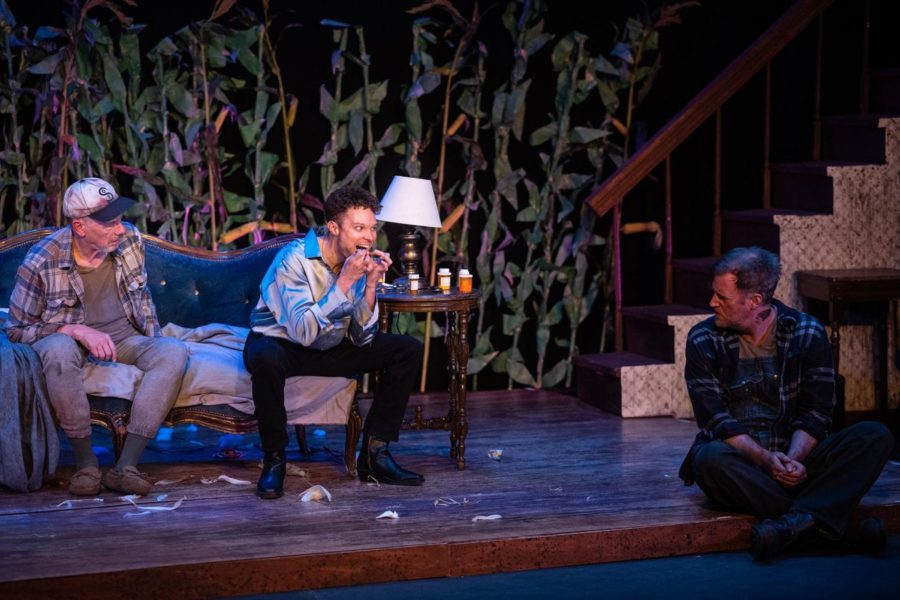At The Edge Theater, north of Chicago, AstonRep Theatre Company opened their 15th and final season with a searing and beautiful production of Sam Shepard’s Pulitzer Prize-winning Buried Child. Written in 1978, the play depicts the disillusionment that accompanies 22-year-old Vince’s return to his family’s Midwestern home. There, he finds his petulant grandfather, Dodge; nostalgic grandmother, Halie; mentally disturbed father, Tilden; and violent uncle, Bradley. Shepard’s play is a masterful examination of Americana and the disintegration of the American Dream, featuring characters that both display great depth of personality and serve as stand-ins for a large population of people in a struggling nation. This production lived up to that sweeping, Pulitzer-Prize winning potential.
The family’s secret—that of the Buried Child—is hidden more than it is unknown. Though this play has been around for half a century, I will not spoil the story, for its slow reveal is truly terrifying. Buried Child possesses a great depth of sorrow and dejection, but this production is as much a horror play as it is a tragedy. Throughout the play, thunder, rain, and periods of darkness produce a spectacle of fear felt by audience members not for themselves, but for the play’s characters. And this fear is a one fear that evokes a genuine sympathy for the people trapped in this tragic tableau vivant and a genuine anguish by play’s end at having felt that sympathy for such people. Buried Child’s characters are menacing, but at their core, they are disheartened. Perhaps the greatest strength of this production and of Shepard’s work is that there clearly seem to be whole lives these people have lived before they walk or hobble onto the stage.
Buried Child’s cast is particularly spectacular. Jim Morley, as Dodge, is magnificent. Bringing an aura of death and decay to the entire show, Morley delivers fully. He and the entire cast are near-flawless in their controlled movements. As Morley stumbles and coughs his way through the play, slowly sinking further and further into the ground, he does not for a second appear to be acting. Morley shifts frighteningly from exhausted crankiness to lonely misery, one moment screaming at his sons and the next crying for them to stay with him. Dodge is a character caught up not only in existential fear but also in perpetual stupor. He sits day and night watching TV, hiding a flask of whiskey, and hoarding a sad gray blanket. Dodge is hanging on to life by the thread of his family’s horrific secret. When he finally, in a brilliant and eerie monologue, divulges that secret to Vince—he dies. Dodge dies almost as he lived: shrunken, putrid, and difficult to witness.
This exploration of suffering turned to sorrow and sin is clear in all the family members, but uncle Bradley and grandmother Halie especially stood out. As Bradley, Rian Jairell, at first entrance, suggests an almost otherworldly beast. Jairell is genuinely terrifying in the role, his thumping walk and erratic demeanor aided in part by strong hair and makeup, creating a contorted visage. And Liz Cloud as Halie is exquisitely, willfully delusional, demonstrating great strength of inflection and emphasis. She seems to float across the stage, pulled earthwards only in proximity to her husband. Cloud’s costuming is particularly well done: As her family members spiral downwards around her, Halie changes from a gloved funeral-esque black dress to a light yellow sundress. This effect is to re-emphasize her deliberate obliviousness.
The visual design of Buried Child, as a whole, is keen-eyed and pretty. Other than Halie, most characters wear simple, well-worn clothes, and Halie’s costumes also stand out from Buried Child’s overall color scheme. This is theater with an almost entirely unified palette and appearance. Dull-toned costumes—blues and grays, mostly—complement a green backdrop of corn stalks and an array of earthy brown furniture. And Buried Child’s lighting, by Samantha Barr, is consistently harmonious and evocative. Barr’s design, a series of near-mono-tinted spotlights and floodlights, creates a succession of startling vignettes.
Buried Child is, in its entirety, a series of startling vignettes. As Tilden shucks corn onstage, as Bradley assaults Shelly, and as Tilden walks upstairs—carrying something he dug up, let’s just say—at the play’s end, Shepard and AstonRep shock and worry the audience into fascination. This is the kind of insanity that seizes rather than repulses. Buried Child is tender, it is terrifying, and above all, it is near-transcendent, terrific theater.
AstonRep’s production of Sam Shepard’s “Buried Child” is at The Edge Theater through November 19th.









